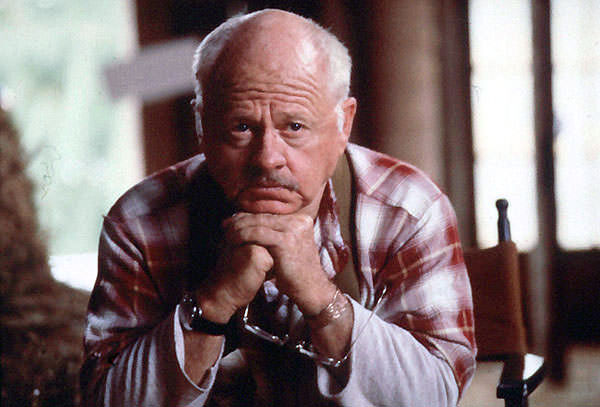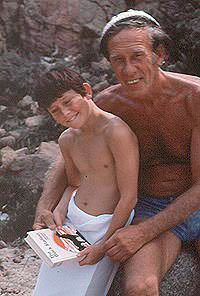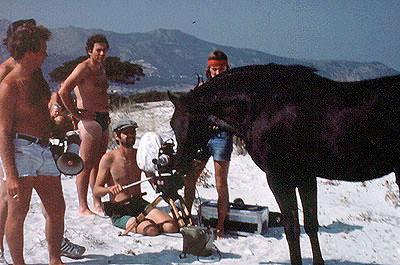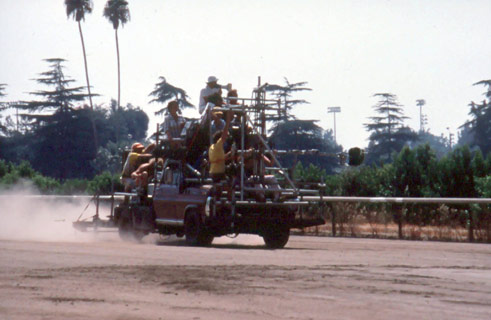The First Black Stallion Movie
Notes by Pauline Kael, New Yorker Magazine

One of the rare movies that achieves a magical atmosphere. Seeing it is like being carried on a magic carpet; you don’t want to come down. (it may be the greatest children’s movie ever made.) In this first feature by Carroll Ballard (as in his earlier short films and documentaries), the visual imagination that he brings to the natural landscape is so intense that his imagery makes you feel like a pagan – as if you were touching when you’re only looking. His great scenes have a sensuous trancelike quality. The movie is set in 1949, but it seems outside time. And this distilled atmosphere makes it possible for a simple boy-and-animal story to be transformed into something mythological. The boy’s sense of wonder recalls “Pather Panchali”, but there are elements of Arabian Nights fantasy that suggests the 1940 “The Thief of Bagdad”, without that films theatricality. When the boy, alone on a desert island with the horse, woos him with a gift of seaweed and finally rides him, you may agree with the man who said that when he saw the movie he felt that he was rediscovering the emotional sources of mystery and enchantment. With Kelly reno as the eleven-year-old boy, and Mickey Rooney, Hoyt Axton, Teri Garr, and Clarence Muse. Based on the 1941 novel by Walter Farley; the screenplay is by Melissa Mathison (who later wrote “ET”), Jeanne Rosenberg, and David D. Witliff. The cinematography is by Daleb Deschanel; the editing is by Robert Dalva.

(Arabian-Horse-World, April 1978) The lights will dim, the curtain will rise, and before there’s time to say Francis Ford Coppola the movie magic of Walter Farley’s THE BLACK STALLION® will unfold on the screen before us. It will all seem quite natural and believable, those incredible feats and heart-thumping adventures. But the production story behind THE BLACK STALLION® almost equals the drama that takes place on the screen. THE BLACK STALLION® is certainly the toughest horse film ever undertaken. Thousands of miles were traversed to kind the right locations necessary for the film, which ranged from period sets resembling Flushing, N. Y. of 1947, to a barren, uninhabited island in the Mediterranean. Two racetracks were required, as were the special effects of a large ship sinking at sea in a violent storm. Most of the action required exterior shooting, leaving both horses and crew at the mercy of prevailing weather. And there was the most unpredictable element of all to deal with, horses which had to perform unique and difficult stunts, frequently in almost inaccessible and dangerous locations.
The first logistical problem was finding an equine star to match the legendary beauty, size and majesty of the “most famous fictional horse of the century.” Producers Tom Sternberg and Fred Roos and director Carroll Ballard spent months searching for the appropriate Arabian stallion, traveling to England, Morocco, Egypt and throughout the United States. At last they found their “star” in San Antonio, Texas— CASS OLE’, one of the most honored Arabian show horses in the United States, owned by 18-year-old Francesca Cuello. He was the Black Stallion®. His rare beauty would thoroughly captivate an audience, and he had the willingness and intelligence to perform the demanding stunts required of the role. Realizing from the start that no one horse could have the full range of attitude and expression necessary for the Black Stallion®‘s transition from terrifying wild stallion to beloved companion, three other horses were trained with CASS OLE’ for the production. FAE-JUR, an Arabian stallion from the Jack Tone Ranch in Stockton, was chosen by director Ballard for his unique liveliness, and two horses owned by stunt coordinator Glen Randall, Jr. were trained more specifically for the fighting and running stunts. All four horses were brought together at the Randall Ranch in Newhall, Cal, in the spring of 1977 for an eleven-week training session before the filming began. Joining them for several weeks was actor Kelly Reno, who plays the role of Alec Ramsey. An excellent rider, Kelly trained with CASS OLE’ and established a rapport with his equine costar that would add immeasurably to the film.

At the end of the training session the horses had been taught to respond to basic visual and vocal commands for such actions as coming when called, being sent away, fuming, walking backwards and laying their heads down. In addition to these standard movements, the horses also learned to put their ears back to show anger, rear, paw the ground, stomp a snake, nod their heads, simulate a kiss with their mouths and lie down. By the time the cameras were ready to roll, the production had its loving horse, its bucking horse, its wild horse and its racehorse.
Behind the Scenes
Arabian-Horse-World, April 1978

Film production divided into two distinct halves as locations were settled. Sardinia was chosen for the island sequences of the film because of the spectacular remote areas of its coast; and Toronto, Canada, was selected as a perfect match for the eastern seaboard of the United States in the late 40’s. Separate production managers and art directors were chosen to oversee the two phases of production, one with largely a Canadian crew, and the other with an Italian crew. Filming began in Toronto on July 4, 1977.
For the sets of Henry Dailey’s (Mickey Rooney) farm and team interiors, two bucolic locations were found in the greater Toronto area about 40 miles from the city center. An abandoned barn, slated for eventual destruction as the site of a new international airport, was refurbished by art director Earl Preston to reveal magical qualities. With light streaming through its 100-year-old frame, an inviting home for the Black Stallion® was created.Two different racetracks were needed, one for the sneak training sessions at night, and another for the match race taking place in Chicago. Fort Erie Racetrack, located on the Ontario border not far from Buffalo, N. Y. was perfect for the 1947 period track with its wooden stands and roof, and Woodbine Racetrack in Toronto was chosen for the night sequences. With the help of the Ontario Jockey Club, a special All-Star Jockey Invitational Race at Fort Erie, including such celebrities as SEATTLE SLEW’s winning jockey Jean Cruguet, was promoted to fill the stands for the filming of the great match race. A huge crowd was drawn to witness the event, but the weather proved uncooperative— rain forced a delay in shooting until the following week, and time was too short to reassemble another full capacity crowd for the second attempt.
Inclement weather would plague the entire Canadian operation. The summer of ’77 was one of the rainiest and hottest on record, with one day’s temperature recorded at 115 degrees. During the night shooting at Woodbine Racetrack, torrential rain created a two-foot-deep mire of mud on the track, further delaying production.
![From left to right - Glenn (Jr) Randall [Stunt Coordinator], Walter Farley, Cass Ole and Corky Randall [Horse Trainer]](https://theblackstallion.com/web/wp-content/uploads/2010/07/From-left-to-right-Glenn-Jr-Randall-Stunt-Coordinator-Walter-Farley-Cass-Ole-and-Corky-Randall-Horse-Trainer-1.jpg)
At the end of August, a thoroughly wet and weary crew headed for the sunnier clime of the Mediterranean, but here a whole new set of problems imposed by remote locations and difficult terrain had to be solved. Horses were transported in one large van which contained portable stalls to be set up and disassembled at each location, while the crew traveled in a caravan, crisscrossing the island.
The first location was the town of Marina di Arbus on the rugged western coast of the island. Access to one area involved a tortuous trek over high sand dunes, with all the camera equipment being hand-carried in and out of the site – a situation the crew learned to accept all over Sardinia.
Arbus was the site of two of the most difficult stunts in the film. The first required the Black Stallion® to swim to shore, dragging young Alec behind him. A feat which posed some unique problems. A special barge had to be constructed on which to load the horse and transport him out to sea to his starting position for the swim to shore. The barge, designed by art director Aurelio Crugnola, was trucked into the location in pieces and assembled under the watchful eye of water specialist Giorgio Gallani. The whole population of Arbus gathered on the beach to help with the assembly and watch the exciting launch, certainly a “happening” for the tiny and remote village. The first attempt at loading the horse onto the barge failed and horse trainer Corky Randall suffered a head injury in the attempt. Thoughts turned to abandoning the project, but eventually the horse became accustomed to the water, and the barge proved invaluable.

The second stunt filmed at Arbus made everyone uncomfortable: a group of deadly cobras were flown in from Milan with their handler Carlo Guidi for the scene in which the Black Stallion® must stomp and kill a snake which is about to strike Alec. The fatal venom was milked from each snake before it was used and a special serum was on hand in case of emergency, but the knowledge that a cobra can travel twice as fast as two legs made everyone extremely nervous.
The discomfort which accompanied these early stunts was not eased by the Spartan living conditions which faced the crew. With no hotel in town, they were quartered in a school dormitory which had no facilities. Exposure to sun, sand, sea and dysentery did not enhance the situation. It was with no small relief that the crew headed for the next location, Capo Caccia, a spectacular spot also on the western coast, where cliffs rise 800 feet from the sea. The spot was chosen for its rocky heights, requiring that all equipment again be hand-carried up vertical precipices. Yet the rigors of the location were more than compensated in the crew’s mind by the availability of a hot bath —the first in ten days.
The third base of operation was La Caletta on the east coast of Sardinia. Filming was done at two nearby sites, Capo Comino and San Teodoro. Comino, one of the locations used by Lina Wertmueller in SWEPT AWAY, had originally been scouted months before as an ideal spot to stage the boy’s first ride on the Black Stallion®. But when the crew arrived for actual filming, the beach was covered with several feet of decaying seaweed, and another beach had to be substituted. San Teodoro beach, about 30 miles away, was judged to be perfect with its mile-long stretch of fine white sugar sand and wide sand bar reaching far offshore, adding greatly to the safety and ease of the horse action shots.
In mid-September, the unit moved to its fourth location, Costa Paradisio. Truly remote, the beach was surrounded by imposing rock formations. Since it was accessible only by boat or a narrow stone path, it was necessary to lead the horses in over the mountains circuitously, a trip which took three hours each way. For the horse crew, the four week stay at Costa Paradisio was an exhausting ordeal, but three outstanding sequences of horse action were completed there: the wild “Black” attacks Alec at a fresh water rain pool when he comes to drink; starving, the stallion accepts and eats seaweed that Alec has found for him, and their friendship is established and the stallion swims out to the rescue ship when fishermen come and take Alec from the island. For the last sequence, special horses were imported from the swamplands of Camargue, France, where an amazing breed has developed which is specially adapted for swimming at sea. The use of these horses greatly lowered the risks entailed in some of the water action shots, and made possible the realistic and stunning shots of “The Black” swimming in the open sea.
The final site was Cala Ganone, on the eastern coast and accessible only by boat. It too was one of the locations used by Line Wertmueller in SWEPT AWAY, and is especially famous for its grottoes. A constant frustration in shooting exteriors on Sardinia was the ever-present sign of civilization. Because the island in the story was totally uninhabited, a special detail of men was assigned each day to comb the beaches for litter and smooth out footprints which were found even on the highest, most inaccessible looking sand dunes. [filming was completed over a nine-week period, and despite the obstacles presented by the difficult terrain, director Carroll Ballard feels the varied and unusual beauty of Sardinia captured on film creates a spectacular backdrop for the movie.
For the last major segment of the movie, cast and crew traveled to the Cinecitta Studios in Rome, where the sinking of the ship “The Drake” was to be accomplished. Two portions of the ship, the deck section and the stern, had been constructed in the studio’s outdoor water tank. Designed and executed by art director Aurelio Crugnola, the sets are the actual size of a passenger ship and the largest ever created in that tank. The stern section, set on a platform of five tracks with cables attached to pull the ship as it is sinking, was built in three parts, all upside down. These sections were then rolled on their right sides by a crane and assembled in the tank, a process which took three months.

Interior sets constructed on the stages included staterooms, corridors and a drawing room, all specially designed and reinforced to withstand huge volumes of water and a wildly i kicking stallion. Fortunately, Crugnola was able to salvage several parts from an old ship slated for destruction, which were used for set decoration and props. When construction was completed, an authentic old art-deco passenger ship had been created. Filming was done during three weeks of night shooting. Precise coordination was required to provide the dazzling sequence in which the Black Stallion® makes his courageous escape from the sinking ship.
A safe path had to be secured for the horse, as action involved a magnificent leap overboard and a swim through storm tossed waters while pulling Alec Ramsay safely to shore. Special effects included fire, rain, wind and high waves, and when all were put into action the noise was so deafening that communication on the set became nearly impossible.
It is to the credit of a tireless and concerned crew that no horses were injured in the entire making of the film, as both action and location presented risks at every turn. When the curtain rises at your local Bijou and you settle comfortably in your seat with a bag of popcorn, what you see may well be the greatest horse film ever made, certainly the toughest. All you have to do is enjoy it, the work’s already been done. (© Copyright 1999 by Arabian-Horse-World, April 1978)
Cast and Credits
Alex Ramsey…………………………………….Kelly Reno
Henry Daley…………………………………….Mickey Rooney
Alec’s Mother………………………………..Teri Garr
Snoe………………………………………..Clarence Muse
Alec’s Father………………………………..Hoyt Axton
Neville……………………………………..Michael Higgins
Jake………………………………………..Ed McNamara
Arab………………………………………..Dogmi Larbi
Jockey #1……………………………………John Burton
Jockey #2……………………………………John Buchanan
Becky……………………………………….Kristen Vigard
Rescue Captain……………………………….Fausto Tozzi
Archaeologist………………………………..John Karlson
Priest………………………………………Leopoldo Trieste
African Chieftain…………………………….Frank Cousins
Taurog………………………………………Don Hudson
Drake Captain………………………………..Marne Maitland
Veterinarian…………………………………Tom Dahlgren
The Black Stallion® is portrayed by: Cass-ole
Owned by San Antonio Arabians
The Film Makers
Executive Producer…………………………Francis Coppola
Produced by…………………………..Fred Roos, Tom Sternberg
Directed by…………………………..Caroroll Ballard
Screenplay by………..Melissa Mathison, Jeanne Rosenberg and William D. Wittliff
From the novel “The Black Stallion®” by Walter Farley
Director of Photography………………….Caleb Deschanel
Editor…………………………………..Robert Dalva
Music by…………………………………Carmine Coppola
Art Directors…………………………….Aurelio Crugnola, Earl Preston
Production Managers………………….Allesandro von Normann, Tedd Holliday
Assistant Director………………………..Doug Clayborne
Horse Trainer…………………………….Corky Randall
Stunt Coordinator…………………………Glenn (J.R.) Randall
Executive Assistant……………………….Jack Fritz
Assistants to the Producer………………..Deborah Fine, Sherry Nisewaner
Production Assistants…………………….Tim Farley, Colin Michael Kitchens
Location Managers Canada……………………Bill Corcoran, David Lister
Supervising Sound Editor…………………..Alan Splet
Associate Editors………………………….Todd Boekelheide, Diana Pellegrini
Music Supervising and Editing……………..Dan Carlin, Jr., La Da Productions Inc.
Sound Editors……Todd Boekelheide, Diana Pellegrini, Stephen Stept, Richard Burrow
Dialogue Editor………………………….John Nutt
Re-recording Mixers………………………Bill Varney, Rick Kline, bob Minkler
Casting US………………………………Vic Ramos
Casting Canada…………………………..Claire Walker, Stuart Aitkens
Second Unit Photographed by………………..Stephen H. Burum, A.S.C.
Additional Photography……………………Robert Dalva
From Omni Zoetrope Studios United Artists/ A Transamerica Company
The Black Stallion® – Movie Reviews
From Amazon.com
Adapted from the beloved novel by Walter Farley, this 1979 family classic was hailed by no less than hard-to-please critic Pauline Kael, who wrote that “it may be the greatest children’s movie ever made.” A visual feast from start to finish, the timeless tale of The Black Stallion® plays out on almost mythic terms. A young boy survives a shipwreck and is stranded on a deserted island with a graceful black stallion, with whom the boy develops an almost empathic friendship. After being rescued and returning home, the two make a winning team as jockey and lightning-fast racehorse under the tutelage of a passionate trainer, played by Mickey Rooney in an Oscar-nominated role. From its serenely hypnotic island sequence to the breathtaking race scenes, this delightful film is guaranteed to enthrall any viewer, regardless of age. The Black Stallion® is a genuine masterpiece of family entertainment. –Jeff Shannon
From Leonard Maltin’s Movie & Video Guide
Exquisitely filmed story of a young boy’s adventures with a magnificent black stallion – from a dramatic shipwreck to a racing championship. Too slow at times, but still worthwhile, with many precious moments, stunning cinematography by Caleb Deschanel, Rooney’s lovely performance as veteran horse trainer. Based on classic children’s novel by Walter Farley. Followed by 1983 sequel, and TV series (with Rooney). Copyright Leonard Maltin, 1998, used by arrangement with Signet, a division of Penguin Putnam, Inc.
Video Description
A family film about the adventures of a young boy and his love for a black, Arabian stallion. The adventures progress from a shipwreck to a racing championship. good performance by rooney as the horse trainer. Academy Award Nominations: Best Supporting Actor – Mickey Rooney, Best Film Editing. –This text refers to the DVD edition of this video
Viewers Comments
A viewer from New York City , July 13, 1999
Visually stunning movie for children and grownups If you’ve never seen The Black Stallion®, you’re in for a real treat. The first section, in which Alec and his horse friend find themselves alone on an island in the Mediterranean, may be the loveliest piece of cinematography ever shot for viewers of any age. The return to civilization is, inevitably, a bit of a let down, but the performances are refreshingly natural, especially the young star. Mickie Rooney reprising an older version of his National Velvet role is a nice touch, though it removes any element of suspense. This movie was produced by Francis Ford Coppola in his salad days: makes you wonder what kind of filmmaker he might have been if he hadn’t got hold of that mafia book…Do not on any account avoid this movie just because you no longer think of yourself as a child. –This text refers to the DVD edition of this video
A viewer from Texas , June 15, 1999
wow…… This movie just flows like music. I saw it for the first time when I was 3 or 4 and I’m still enchanted whenever I see it. A masterpiece of visuals, of beautiful and haunting music, a talented child actor, and one drop-dead GORGEOUS horse! It does get a bit slow in some parts, but these segments are negligible in light of the rest of the movie. –This text refers to the DVD edition of this video
A viewer from Los Angeles, CA , December 24, 1998
Cinematography and visual storytelling at its best If you can get past the labeling of “children’s story” or “melodramatic fable”, The Black Stallion® has the kind of stunning filmwork reserved only for the grandest epics. The first half of the movie — about a boy and horse shipwrecked on a small island — is basically a silent movie. It is a story of friendship and trust that is told without the benefit of dialog. Deschanel’s wonderful cinematography conveys both the island’s beauty and Farley’s storytelling without becoming maudlin or trite. The still photography alone brings to mind Adams, and the haunting score is near perfect for the occasion. The second half of the film reverts back to a formulaic Nerd-wins-Girl, or in this case, Boy-and-Horse-Win-Big-Race, but the performances are superb and the movie never patronizes to its adult viewers. Predictable ending aside, The Black Stallion® is an awesome, visual masterpiece masquerading as a children’s movie. –This text refers to the DVD edition of this video
A viewer from phoenix, az , November 29, 1998
enthralling tale of a boy’s bond with a horse moving and enthralling tale of a boy who comes to terms with his loss and learns to survive with the comfort and love of a horse. Patience is required as it moves seemingly slow at times, but the drama of the story draws you in. Excellent children’s movie for a thoughtful child.
A reader, July 7, 1998
A must-have for any horse lover! If you’ve read the Walter Farley series, you MUST see the movie! Also a musical pleasure – the score will bring you goosebumps. Cinematography: excellent. This movie is absolutely beautiful. –This text refers to the DVD edition of this video
